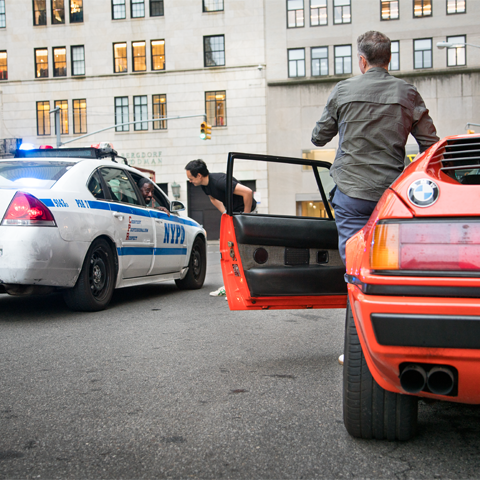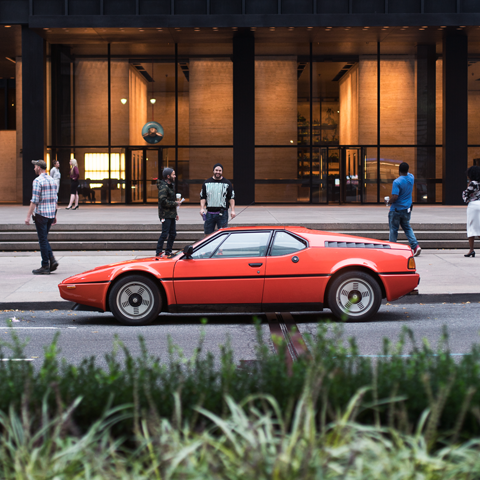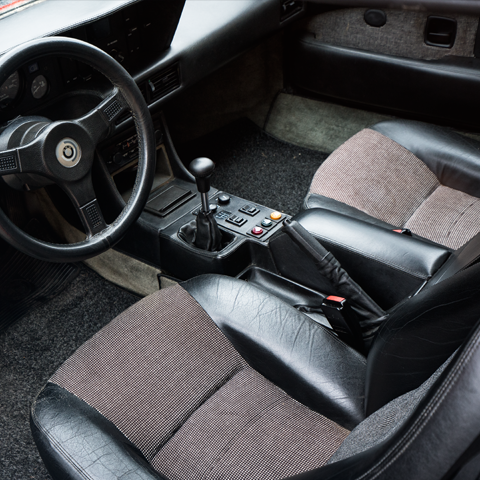BMW’s M1 was bred for the track yet turned out an unusually refined supercar. So let’s test it on the streets of Manhattan...
Words: Simon Aldridge. Photography: Erik Fuller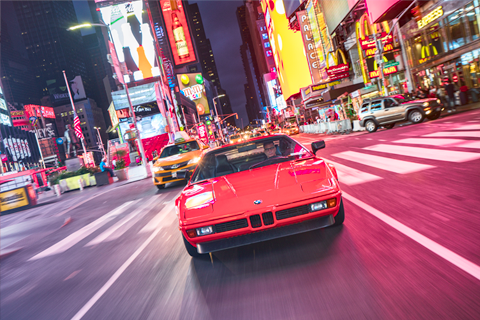
The darkest hour of the day is just before dawn. And at this ungodly hour, the neon- lit quietude of Times Square is ruptured by the bark of a race-derived straight-six revving to the limiter and the explosions of unburnt fuel on the overrun, together announcing the arrival of the bright orange BMW M1.
This is how Phillip Toledano enjoys his collection, in dawn raids on a deserted New York City. It’s six o’clock on a Sunday morning and we have some of the most famous streets in the world almost to ourselves. Born in London, Toledano is an artist and photographer who has called Manhattan home for over 25 years. When he started his car collection he favoured Italian beauties such as the Ferrari Dino 246 GT, Lancia Flaminia Sport Zagato and Iso Grifo. A chance encounter with an M1 changed that.
‘I was at a dealer to drive a De Tomaso Mangusta, which is a stunning car to look at, but I was disappointed when I drove it. Then the dealer said “Why don’t you try the M1?” I had never thought about getting an M1 before that moment but, since I was there, I gave it a try... well, the first time I gave it some wellie it was like my balls were on fire! I haven’t looked back since.’
To translate for our international audience: Phil loved the M1, especially the howl and thrust of the race-bred straight-six as it neared the red line. He instantly became a convert to cars of its era and, in particular, competition cars for the road, such as the M, and other homologation specials. So, in addition to the M1, his garage now houses a Lancia Delta S4 Stradale, Lancia 037, Porsche 924 GTS Carrera Club Sport, and a Peugeot 205 T16.
‘These cars are just so special, and everything about them was there for a purpose – they were designed to win races, then turned into street cars, rather than the other way around.’
The M1 is a particularly well-resolved example of this. Look closely and those race-car details are evident everywhere, from the air intakes and airflow management of the bodywork, to the formula-car length of the rear suspension’s lower control arms, peeking out below the valance. Opening the engine cover reveals an engine set as low as possible in the chassis – thanks to dry-sump lubrication – yet there’s also a generous and practical carpeted cargo area. The Giugiaro silhouette is clean, sharp, elegant, and its glassfibre bodywork exhibits an unusually impressive level of fit and finish. So yes, it’s a race car, but one you really can use on the road.
In the modern context, the M1’s usability becomes even more striking. Watch it ride over the potholed avenues of Manhattan and the suspension actually looks supple. The ride height is reasonable and the tyres’ sidewalls – by today’s standards – are generous. And what streets these are. The lights of Times Square amplify the sensation of speed, while the walls of glass and polished stone reflect the M1’s orange wedge shape and its operatic voice to profound effect.
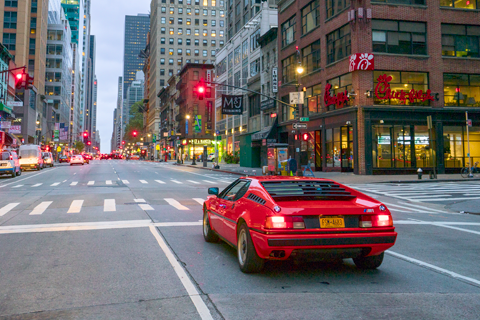 To say that the M1 is only about the engine would be inaccurate, but that straight-six is a masterpiece. Paul Rosche and his team had created a pure race engine – the M49/2 – for Group 5 and IMSA racing and fitted it to the 3.5 CSL race car, which Peter Gregg and Brian Redman drove to victory in the 1976 24 Hours of Daytona, BMW’s first major victory on American soil. When BMW decided to develop the M1 as a new purpose-built race car for Group 4 and 5 racing, it created a new version of that race engine designated M88/1 (see pages 74-76), developed for the 400 cars required for homologation. Marque experts now think that only 399 street cars were actually built, plus a further 54 race cars. And you can read more about those on pages 78-79.
To say that the M1 is only about the engine would be inaccurate, but that straight-six is a masterpiece. Paul Rosche and his team had created a pure race engine – the M49/2 – for Group 5 and IMSA racing and fitted it to the 3.5 CSL race car, which Peter Gregg and Brian Redman drove to victory in the 1976 24 Hours of Daytona, BMW’s first major victory on American soil. When BMW decided to develop the M1 as a new purpose-built race car for Group 4 and 5 racing, it created a new version of that race engine designated M88/1 (see pages 74-76), developed for the 400 cars required for homologation. Marque experts now think that only 399 street cars were actually built, plus a further 54 race cars. And you can read more about those on pages 78-79.
Toledano’s car is one of the last built, a 1981 model that was BMW’s press car for a time, and it is in glorious original condition. As he pulls over by Mies van der Rohe’s Seagram building to let me take the wheel, Toledano is well aware that the charismatic engine has already made an impression on me. Access is straightforward and he sits quietly as I familiarise myself with the controls. The driving position is good – much better than the mid-engined Ferrari and Lamborghini road cars of the period – with pedals that are only slightly offset, and there is plenty of room for regular footwear. The gearbox, as befits a race car, has a dogleg first and then a straight H-pattern for the upper four gears. You are aware of long linkages at work to reach the ZF transaxle, but the movement is precise enough once you know the pattern and have learned the motion. Slick it is not, but it gives the impression of being bulletproof, a fact borne out by the race versions that, with turbocharging, produced more than 850bhp.
The cabin is remarkably modern for a car that made its debut in 1978, with air-conditioning, electric windows and electric mirrors. It has a teutonic charm to it, with black hand-stitched leather covering the Bauhausian rectilinear forms. The seats have chequered fabric inserts that add to the grip of their bolstered sides, and the steering wheel is a unique three-spoker (although it was later used on the M535i), with the BMW Motorsport insignia rather than the traditional blue-and-white BMW roundel.
The view out is unobstructed to the front and sides, with none of the bodywork visible. Towards the rear, however, it’s dominated by louvres and fins that shade the rear screen and channel air to the engine’s intakes around the side windows. It is a glorious riot of forms that remind you this was an Italo-German collaboration, designed by BMW together with Giugiaro and Lamborghini engineer Gian Paolo Dallara.
Toledano recommends that I pull away without too much tickling of the throttle, and as I make an experimental blip I understand why – the throttle has a sticky motion at the top, so tipping into it takes some commitment; it’s the result of a long and complicated linkage from pedal to six individual Kugelfischer throttle bodies. Combined with a light brake pedal, it makes heel-and-toe work a bit of a challenge if you are driving at anything less than ten-tenths commitment – no problem here in New York, of course.
I let out the smooth clutch with the engine at idle and pull away. Pressing the accelerator firmly to get past the initial stiction and shifting across the gate into second, the car feels ready for action, fluids warmed (thanks, Phil) and the engine eagerly waiting for the next burst of acceleration. That ‘begging for it’ attitude is one of my favourite aspects of race engines, and this one has it in spades. I shift quickly down into third and press the loud pedal deep into its travel again. The engine is screaming, egging me on to give it more all the time – Toledano is grinning in his seat and I am yelling that the engine sounds even more epic from my side. ‘Yes – the exhaust’s on the driver’s side!’ he grins.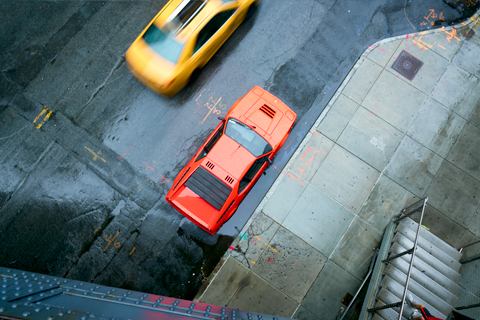
The next few miles we spend snaking through slower traffic, accelerating into gaps and powering through the turns. The unassisted steering is not heavy and it’s very neutral in weighting, with little castor to make the self-centring stronger at speed. We turn along Park Avenue, cutting over Fifth to the Plaza hotel, where we park out front for a chat with some friendly NYC cops – they are big fans of the M1 too. Later, sitting at the lights on Sixth Avenue feels like the start of a Grand Prix. All the lights turn green at once, and away we go, up through the gears again.
The West Side Highway is a chance to really open it up on some bends, as is the highway on the other side of the Holland tunnel, when we are en-route back to the anonymous garage building where Toledano houses his collection. Powering through some higher- speed turns, the chassis feels solid and planted, but at the same time light on its feet. It’s a neat trick that the best cars can pull off, and it makes the M1 seem years younger then it really is.
Contemporary road tests described the steering as one of the best features of the car, and I appreciate the transparency of its communication. At one point I enter a left-hander at speed, only to find that it tightens significantly towards the end, but the car instils confidence. Nothing happens when I back-off slightly on the throttle, the car remaining rock-steady, and the information flowing through the wheel (and seat of the pants) says that it has plenty of grip in reserve. It’s an impressive package, and one that you can imagine pushing hard over long days at the wheel.
Car and Driver tested a European-spec car in 1981 and published a result of 0.82g for its lateral cornering, which was pretty impressive for a car on 255-section tyres. Performance was on par with the leading supercars of the time but achieved through lighter weight rather than brute power – it’s hard to know which other car of 1978 could have kept up with a well- driven M1. The Lamborghini Countach and Ferrari 512 were significantly heavier, while the Ferrari 308 weighed around the same but had much less power. Only the Porsche 911 Turbo came close, so it makes sense that on track the main rival to the M1 Procar was the Porsche 935.
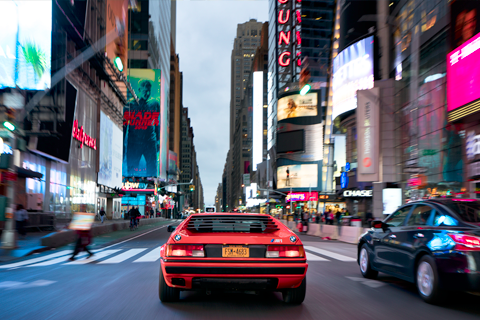 The contrast between the M1 then and now is striking. It couldn’t be more relevant today, yet at the time it was overlooked. In period, for many journalists the M1 was a car that had already lost its raison d’être at launch, the silhouette formula for which it was developed having been cancelled during its long gestation. Furthermore it was emblematic of a failed partnership between BMW and Lamborghini, as it was caught up in (and delayed by) the Italian manufacturer’s bankruptcy. Many journalists who drove the M1 talked more about its usability and tractability than of its dynamic prowess. Here was a supercar that wasn’t as challenging as the Italians. How boring!
The contrast between the M1 then and now is striking. It couldn’t be more relevant today, yet at the time it was overlooked. In period, for many journalists the M1 was a car that had already lost its raison d’être at launch, the silhouette formula for which it was developed having been cancelled during its long gestation. Furthermore it was emblematic of a failed partnership between BMW and Lamborghini, as it was caught up in (and delayed by) the Italian manufacturer’s bankruptcy. Many journalists who drove the M1 talked more about its usability and tractability than of its dynamic prowess. Here was a supercar that wasn’t as challenging as the Italians. How boring!
We have enjoyed this M1 through the night into the day, and the sun is now rising. We let the car cool down and drink in its shape one more time, reflecting on the journey that the M1 has taken in the minds and hearts of enthusiasts. It is finally having its time in the limelight, having come of age. The M1 was a shortlived journey into supercars for the Bavarian marque but it marked a sea-change in how a supercar could be perceived, and how it could be used. Today, BMW builds the bang-up-to-date i8 – a car that makes the current supercar crop look old-fashioned, even a generation behind. It’s something that, with hindsight, we can say the M1 did in 1978.
1981 BMW M1
Engine 3453cc dry-sump straight-six, DOHC, 24-valve, Kugelfischer mechanical fuel injection with six individual throttle bodies Power 277bhp @ 6500rpm Torque 243lb ft @ 5000rpm Transmission Five-speed manual ZF transaxle, limited-slip differential, rear-wheel drive Steering Rack and pinion Suspension Front and rear: MacPherson struts, coil springs, double unequal-length control arms, height-adjustable Bilstein dampers, anti-roll bar Brakes ATE vented discs Weight 1300kg Top speed 161mph 0-60mph 5.4sec
